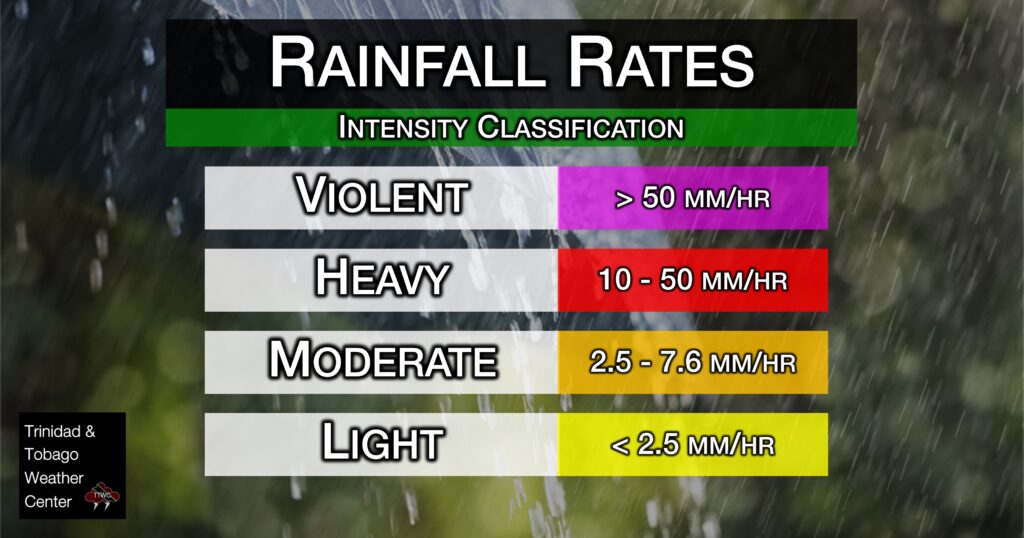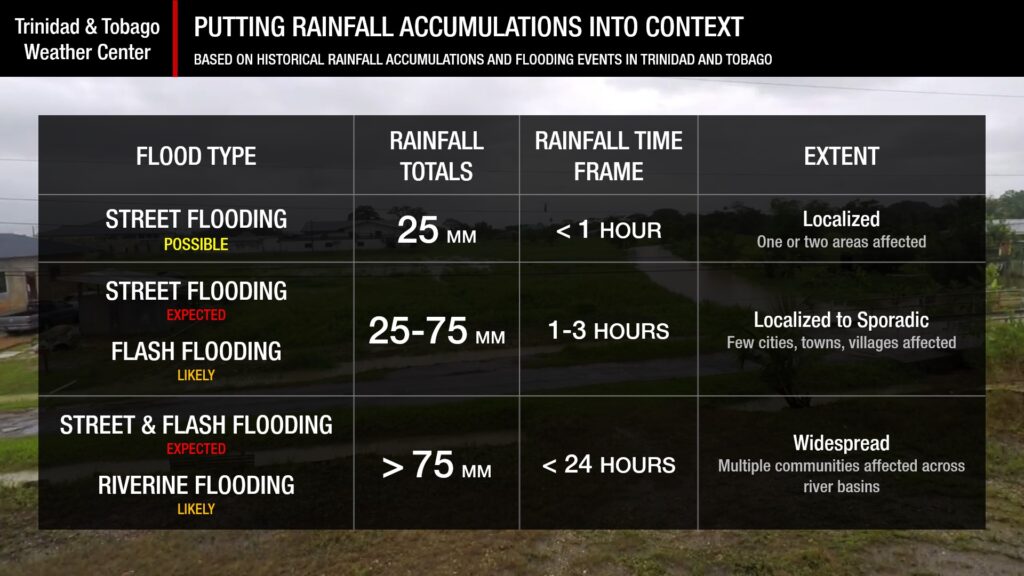Trinidad and Tobago is forecast to see welcome showers and some of the first thunderstorms for the year over the next three days. However, with the potential for locally heavy rainfall and thunderstorms, too much of a good thing isn’t always good – as the threat of street/flash flooding returns.
What you need to know
— Rainfall: Over the next five days, between 15 and 50 millimeters of rainfall are forecast across most of Trinidad and Tobago, with isolated totals nearing 75 millimeters possible across the southern and eastern halves of both islands. In areas of isolated heavy showers/thunderstorms, locally higher amounts are possible.
— Saharan Dust: Mild to moderate Saharan Dust is forecast to be present across T&T through the forecast period, with a moderate surge forecast by Thursday.
— Hazards: Through Wednesday, the main hazards will be street/flash flooding in heavy showers/thunderstorms, which may be accompanied by gusty winds exceeding 45 KM/H, as well as lightning in thunderstorm activity. From Thursday, reduced air quality and localized street flooding will be the main concerns.
— Marine: Seas are forecast to be moderate over the next five days, with waves in open waters generally between 1.5 and 2.0 meters. In sheltered areas, waves are forecast to be up to 1.0 meters and choppy in showers/rain. Long-period swells are forecast to subside by midday Monday but return from Wednesday.
Latest Alerts
TTMS Issues Adverse Weather Alert For T&T
Trinidad and Tobago is NOT under any tropical storm or hurricane threat, watch, or warning at this time.
The Forecast
Monday
MondayTuesday
TuesdayWednesday
WednesdayThursday
ThursdayFriday
FridayMarine Forecast
Slight to Moderate Seas Forecast For T&T
Temperatures
Monday
Low: 23-25°C
High: 31-33°C
Tuesday
Low: 23-25°C
High: 28-30°C
Wednesday
Low: 23-25°C
High: 30-32°C
Thursday
Low: 22-25°C
High: 32-33.5°C
Friday
Low: 22-25°C
High: 32-33.5°C
Forecast Impacts
Flooding
FloodingForecast Rainfall Totals
- Monday: Between 5 and 15 millimeters of rainfall across the country, with isolated totals up to 35 millimeters favoring southern and eastern coastal Trinidad and western coastal Trinidad, mainly due to heavy shower/thunderstorm activity.
- Tuesday: Between 10 and 25 millimeters of rainfall across the country, with isolated totals as high as 50 millimeters across Tobago, northern, western coastal and eastern coastal Trinidad. In northeastern areas, locally higher amounts are possible.
- Wednesday: Less than 5 millimeters of rainfall across most areas of the country, with isolated totals between 5 and 20 millimeters favoring eastern, southern, and western coastal Trinidad.
- Thursday: Little to no rainfall across Trinidad and Tobago, with isolated totals up to 5 millimeters across eastern Trinidad and Tobago.
- Friday: Little to no rainfall across Trinidad and Tobago, with isolated totals up to 5 millimeters across eastern Trinidad and Tobago.

Understanding Rainfall Accumulations
Putting the rainfall forecast into context, rainfall rates in excess of 50 millimeters per hour or areas that receive in excess of 25 millimeters within an hour tend to trigger street flooding across the country or flash flooding in northern Trinidad. For riverine flooding to occur, a large area of the country (not just in highly localized areas of western coastal Trinidad) would have to record upwards of 75 millimeters within 24 hours, and rainfall would have to fall across major rivers’ catchment areas.

Strong Thunderstorms
Strong ThunderstormsWhat is a strong or severe thunderstorm?
Given how rare these types of thunderstorms are in our region – we classify a severe or strong thunderstorm as one that produces any of the following:
- Damaging wind gusts exceeding 55 KM/H;
- Frequent lightning (more than 30 cloud-to-ground strikes within a 10-minute period);
- Hail (of any size);
- Rainfall of more than 50 millimeters or more within an hour or exceeding 75 millimeters or more within three hours;
- The sighting of a funnel cloud or touchdown of a waterspout/tornado associated with the thunderstorm.
Gusty Winds
Gusty WindsWith winds gusting to 50 KM/H and occasionally above, whole trees can be in motion, with larger trees and weaker branches falling. Light outdoor objects can topple or become airborne, such as garbage cans, loose galvanize, construction material, and outdoor furniture. Tents may also jump.
Other Hazards
Saharan Dust Forecast
Dust-Free Days Ahead For T&T As Saharan Dust Stays North
Why I May Not/Will Not See Rainfall?
A frequent complaint is the forecast is wrong because I didn’t experience any rainfall. Scattered showers mean that you, individually, may experience some showers intermittently throughout the day, and there is a higher chance for this activity than isolated activity. Widespread showers mean that nearly all persons and areas may experience rainfall.
Most areas should receive some rainfall between Monday and Wednesday. Thereafter, highly isolated rainfall is forecast.

Forecast Discussion
While at the surface to low levels of the atmosphere, the prevailing Atlantic high-pressure system will still be dominating, an increase in low-level convergence, atmospheric moisture, and favorable upper-level conditions are forecast from Monday through Wednesday, with peak favorable conditions for showers and thunderstorms on Tuesday.
This area of low-level convergence is forecast to be near T&T from early Monday, resulting in scattered showers, mostly cloudy to overcast skies, and isolated thunderstorms. Increasing cloudiness is expected into the evening and night.
On Tuesday, an upper-level jet is forecast to shift across the Lesser Antilles while an upper-level trough remains over the Caribbean Sea. The result will be favorable upper-level divergence coupled with favorable low-level convergence. Current forecast models indicate the most favorable area is forecast to remain southeast and east of Trinidad and Tobago, with the highest rainfall accumulations staying offshore. Note that strong westerly wind shear will also play a factor in keeping the highest rainfall accumulations offshore as well.
By Wednesday, the atmosphere becomes increasingly dry, the upper-level trough weakens, as well as low-level convergence leading to more isolated shower activity, and reduced thunderstorm chances.
From Thursday into the weekend, a dry atmosphere is forecast to return to Trinidad and Tobago as a surge of Saharan Dust moves in, the Atlantic high-pressure system restrengthens, and low-level wind speeds increase across T&T.
Note that as an extended forecast goes further into the future, it is normal for the certainty to be reduced relative to the extended period.












